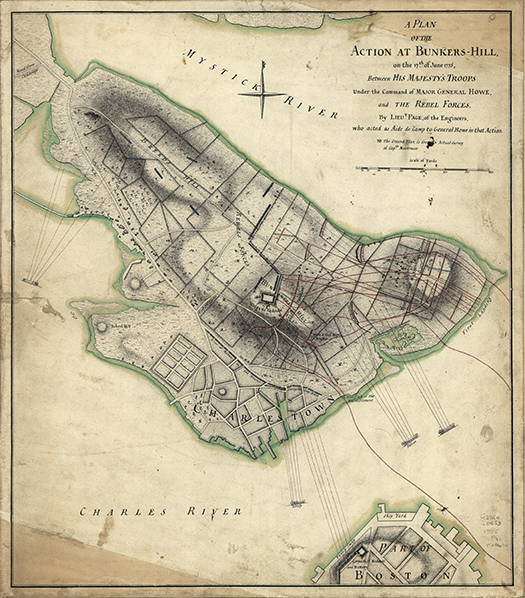“Do not fire until you see the whites their eyes”

The battle of Bunker Hill took place throughout the hilly pastures of Charlestown, a town just north of Boston. While named after the highest hill in the area, Bunker Hill, the battle took place on Breed’s Hill, the hill situated closest to the Charles River. The battle between the British and Americans lasted about two hours and ended with a win for the British. The victory for the British, however, came at a heavy price.
In the early days of the American Revolutionary War, on June 17, 1775, colonial militia forces clashed with the British Army in a fierce engagement known as the Battle of Bunker Hill. While technically a British victory, the battle proved to be a sobering experience for the Crown forces due to their staggering losses and served as a significant morale booster for the fledgling American cause.
The conflict unfolded on the Charlestown Peninsula, across the Charles River from Boston, where thousands of colonial militia had gathered to lay siege to the British-occupied city. The strategic high ground of the peninsula, particularly Bunker Hill and the adjacent, lower Breed’s Hill, offered a commanding position to bombard the British.
The Fight for the High Ground
On the night of June 16, under the command of Colonel William Prescott, about 1,000 colonial troops were dispatched to fortify Bunker Hill. However, for reasons that remain a subject of historical debate, they instead established their primary defensive position—a square earthen redoubt—on Breed’s Hill, which was closer to Boston.
As dawn broke, the British, led by Major General William Howe, were stunned to see the fortified hill. Recognizing the threat, they quickly organized a force of over 2,000 soldiers to assault the American position.
A Brutal Engagement
The British forces launched three separate, frontal assaults on the entrenched colonial militia. The American defenders, famously ordered by Prescott to “not fire until you see the whites of their eyes” to conserve their limited ammunition, unleashed devastating volleys of musket fire upon the advancing Redcoats. The first two British charges were repelled with heavy casualties.
The tide turned during the third and final British assault. By this point, the American militia were critically low on ammunition and unable to withstand the renewed attack. The British troops, now charging with bayonets, overran the redoubt. The ensuing hand-to-hand combat forced the colonists to retreat from the peninsula.
A Pyrrhic Victory and its Aftermath
The British had taken the ground, but at a tremendous cost. They suffered over 1,000 casualties, including a significant number of officers. In stark contrast, the American casualties were estimated to be around 450. The high price of victory led British General Henry Clinton to famously remark, “A few more such victories would have shortly put an end to British dominion in America.”
Among the American losses was the respected patriot leader, Doctor Joseph Warren, who was killed during the final moments of the battle. His death was a significant blow to the revolutionary cause.
Despite the loss of the Charlestown Peninsula, the Battle of Bunker Hill had a profound impact on the American psyche. The colonists had stood their ground against a professional army and inflicted severe damage. This demonstration of their resolve and fighting capability instilled a newfound confidence and determination, proving that they could contend with the might of the British military. The battle dispelled any illusions of a quick and easy suppression of the rebellion and set the stage for a long and arduous war for independence.
